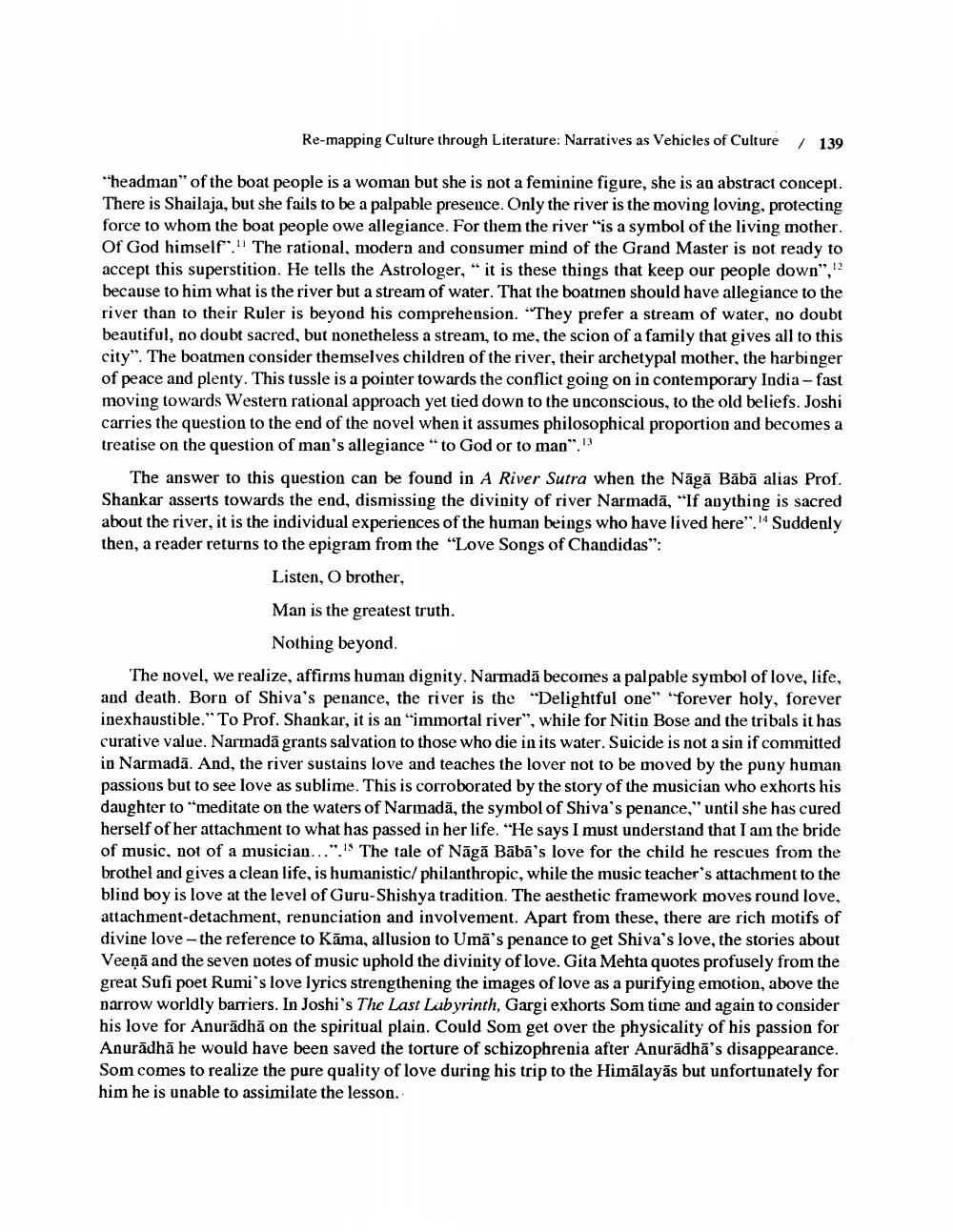________________
Re-mapping Culture through Literature: Narratives as Vehicles of Culture
/ 139
"headman" of the boat people is a woman but she is not a feminine figure, she is an abstract concept. There is Shailaja, but she fails to be a palpable presence. Only the river is the moving loving, protecting force to whom the boat people owe allegiance. For them the river "is a symbol of the living mother. Of God himself." The rational, modern and consumer mind of the Grand Master is not ready to accept this superstition. He tells the Astrologer, “it is these things that keep our people down","2 because to him what is the river but a stream of water. That the boatinen should have allegiance to the river than to their Ruler is beyond his comprehension. They prefer a stream of water, no doubt beautiful, no doubt sacred, but nonetheless a stream, to me, the scion of a family that gives all to this city". The boatmen consider themselves children of the river, their archetypal mother, the harbinger of peace and plenty. This tussle is a pointer towards the conflict going on in contemporary India - fast moving towards Western rational approach yet tied down to the unconscious, to the old beliefs. Joshi carries the question to the end of the novel when it assumes philosophical proportion and becomes a treatise on the question of man's allegiance "to God or to man"."
The answer to this question can be found in A River Sutra when the Nāgā Bābā alias Prof. Shankar asserts towards the end, dismissiog the divinity of river Narmadā, “If anything is sacred about the river, it is the individual experiences of the human beings who have lived here". Suddenly then, a reader returns to the epigram from the “Love Songs of Chandidas":
Listen, O brother, Man is the greatest truth.
Nothing beyond. The novel, we realize, affirms human dignity. Narmadā becomes a palpable symbol of love, life, and death. Born of Shiva's penance, the river is the "Delightful one" "forever holy, forever inexhaustible." To Prof. Shankar, it is an immortal river", while for Nitin Bose and the tribals it has curative value. Narmadā grants salvation to those who die in its water. Suicide is not a sin if committed in Narmadā. And, the river sustains love and teaches the lover not to be moved by the puny human passious but to see love as sublime. This is corroborated by the story of the musician who exhorts his daughter to "meditate on the waters of Narmadā, the symbol of Shiva's penance," until she has cured herself of her attachment to what has passed in her life. "He says I must understand that I am the bride of music, not of a musician...". The tale of Nāgā Bābā's love for the child he rescues from the brothel and gives a clean life, is humanistic/philanthropic, while the music teacher's attachment to the blind boy is love at the level of Guru-Shishya tradition. The aesthetic framework moves round love, attachment-detachment, renunciation and involvement. Apart from these, there are rich motifs of divine love - the reference to Kāma, allusion to Umā's penance to get Shiva's love, the stories about Veeņā and the seven notes of music uphold the divinity of love. Gita Mehta quotes profusely from the great Sufi poet Rumi's love lyrics strengthening the images of love as a purifying emotion, above the narrow worldly barriers. In Joshi's The Last Lubyrinth, Gargi exhorts Som time and again to consider his love for Anurādhā on the spiritual plain. Could Som get over the physicality of his passion for Anurādhā he would have been saved the torture of schizophrenia after Anurādhā's disappearance. Som comes to realize the pure quality of love during his trip to the Himālayās but unfortunately for him he is unable to assimilate the lesson.




